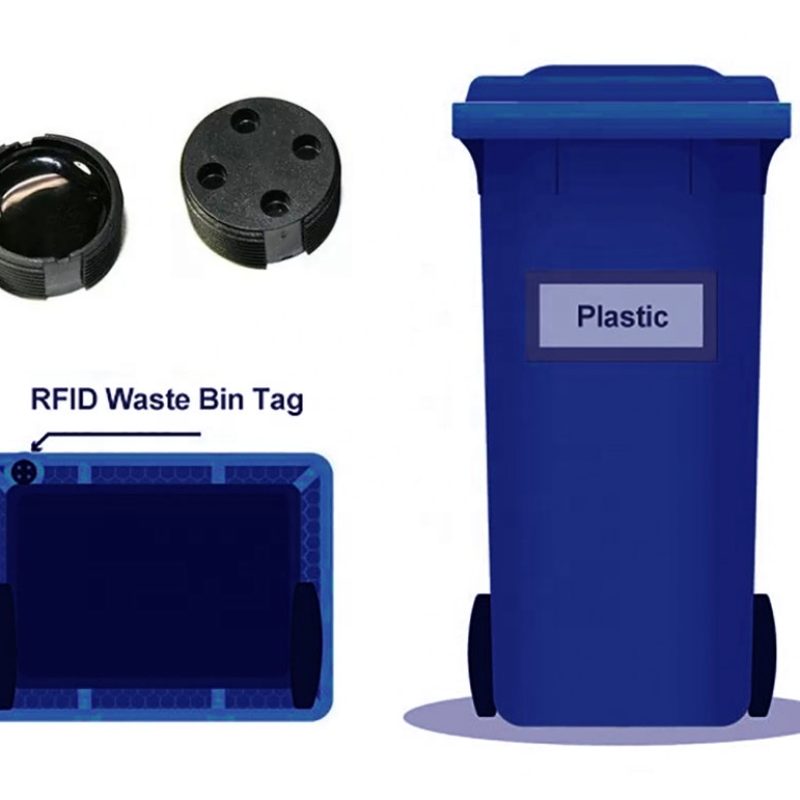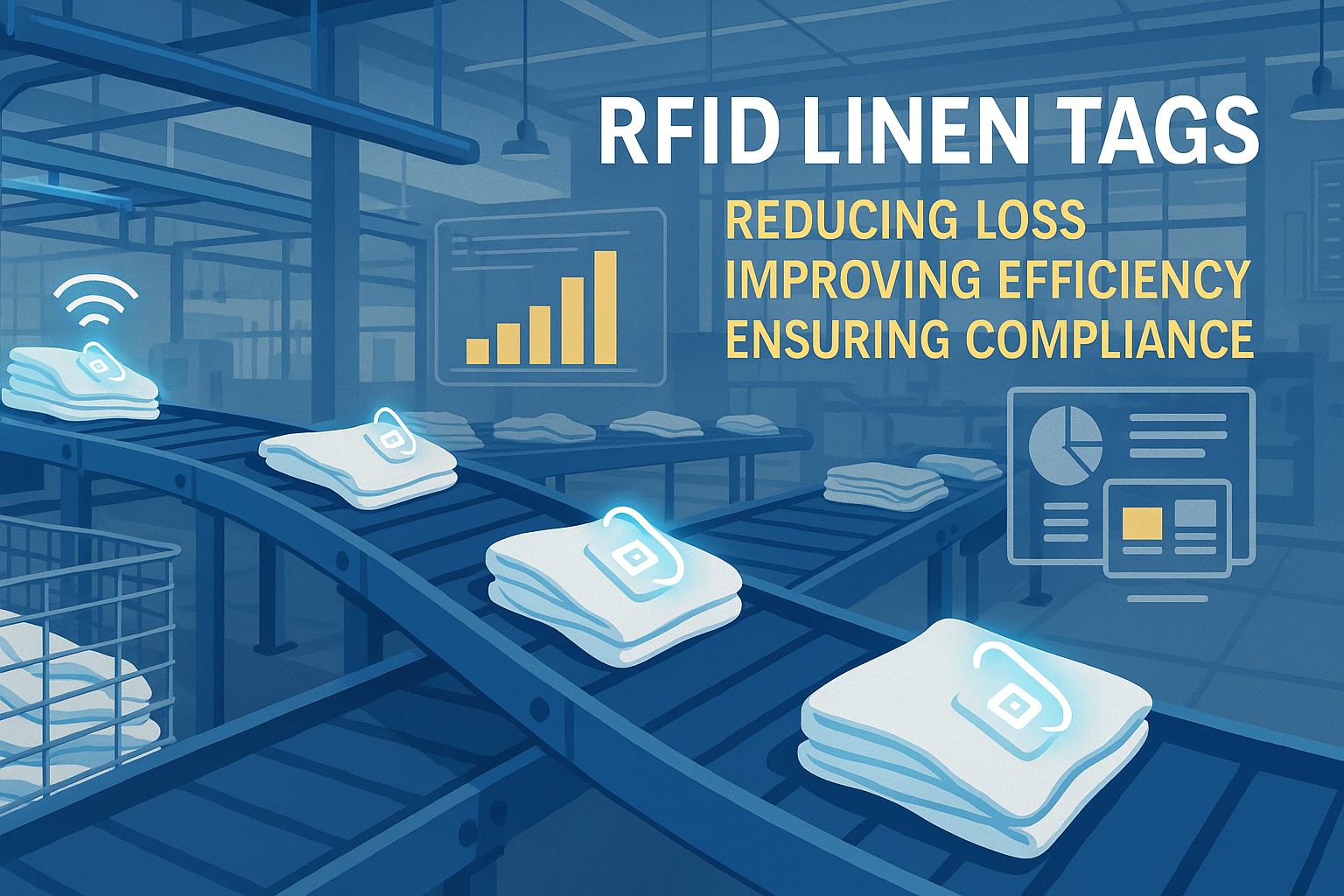
Wat is RFID-afvalbeheer?
Inhoudsopgave
Inleiding tot RFID-afvalbeheer
“RFID”, kort voor Radio-Frequency Identification, is een technologie die gebruikmaakt van radiogolven om items automatisch te identificeren en te volgen. Wanneer deze technologie wordt toegepast op afvalsystemen, kunnen steden en bedrijven het volledige traject van afval volgen – van inzameling tot transport en verwijdering. Het is een van de meest veelbelovende innovaties op het gebied van slimme stadsinfrastructuur, die helpt om afvalinzameling efficiënter, transparanter en milieuvriendelijker te maken.
Wat is RFID-afvalbeheer?
RFID-afvalbeheer houdt in dat kleine RFID-tags worden aangebracht op afvalbakken, zakken of karren. Deze tags worden gescand door RFID-lezers die zijn geïnstalleerd op vuilniswagens of in sorteerinstallaties. Bij elke scan worden gegevens zoals tijd, locatie, bak-ID en zelfs gewicht geregistreerd.
Het is alsof elke afvalbak een digitale identiteitskaart krijgt. Wanneer de vuilniswagen langskomt, weet het systeem precies welke afvalbak is geleegd, wanneer en door welk voertuig. Dit maakt volledige traceerbaarheid en automatisering van het inzamelingsproces mogelijk.
Steden en particuliere exploitanten maken nu bijvoorbeeld gebruik van RFID-baklabels op huishoudelijke afvalcontainers om ophalingen te controleren, gemiste ophalingen te verminderen en facturering te automatiseren.

Hoe RFID-afvalbeheersystemen werken
Elk RFID-afvalbeheersysteem bestaat uit drie hoofdonderdelen:
- RFID-tags: Kleine elektronische chips die op afvalbakken of containers worden geplaatst.
- RFID-lezers: Apparaten die op vuilniswagens of bij inzamelpunten zijn gemonteerd en die de tags scannen.
- Backend-software: Een beheerplatform dat de gegevens verzamelt en analyseert.
Wanneer een vrachtwagen voorbijrijdt, detecteert de lezer tags in de buurt en registreert hij de gegevens van elke container: locatie, tijdstip en bevestiging van ophaling. Deze informatie wordt naar een database gestuurd waar operators dashboards, prestatiestatistieken en routegeschiedenis kunnen bekijken.
Geavanceerdere systemen integreren RFID-afvalbaklabels met sensoren die het vulniveau of gewicht meten. In combinatie met GPS en routeoptimalisatiesoftware helpt RFID steden om de afvalinzameling nauwkeurig te stroomlijnen.
Voordelen en toepassingen van RFID in afvalbeheer
Dit is waarom steden en bedrijven RFID-afvalbeheer invoeren:
- Routeoptimalisatie: Vrachtwagens slaan lege containers over, waardoor brandstof en tijd worden bespaard.
- Nauwkeurige facturering: Ondersteunt pay-as-you-throw-programma's waarbij bewoners worden gefactureerd op basis van het werkelijke afvalvolume.
- Betere verantwoordingsplicht: Elke afvalophaaldienst wordt geregistreerd, waardoor klachten en gemiste ophalingen worden verminderd.
- Verbeterde recycling: RFID-gegevens helpen bij het identificeren van afvalsoorten voor betere sorteer- en recyclingpercentages.
Voorbeelden hiervan zijn gemeenten die RFID-tags op afvalcontainers gebruiken om te controleren of de dienstverlening is voltooid, en industriële faciliteiten die RFID gebruiken voor het volgen van gevaarlijk afval, waardoor naleving van de regelgeving en traceerbaarheid worden gewaarborgd.
Praktijkvoorbeelden en casestudy's
Steden over de hele wereld maken al gebruik van RFID-afvalbeheer om hun systemen te moderniseren — en de resultaten zijn meetbaar.
Amsterdam
Amsterdam heeft RFID-tags op alle huishoudelijke afvalbakken geïnstalleerd. De resultaten waren duidelijk:
- 15% minder gemiste ophalingen
- Gestroomlijnde inzamelingsroutes met behulp van realtime gegevens
- Aanzienlijke vermindering van het brandstofverbruik en de rijtijden
Seoul
Het pay-per-use-programma voor voedselafval in Seoul maakt gebruik van RFID-tags op afvalbakken om de afvalverwerking bij te houden. Bewoners tikken met een RFID-kaart op slimme afvalbakken; het systeem weegt het afval en brengt de kosten in rekening. Sommige districten meldden een vermindering van meer dan 30% aan voedselafval dankzij dit systeem.
Particuliere vervoerders
Particuliere afvalverwerkingsbedrijven gebruiken RFID-afvalbeheertechnologie ook om:
- Volg commerciële pick-ups in realtime
- Automatiseer facturering
- Identificeer serviceproblemen nog voordat klanten ze opmerken
RFID versus barcode voor het volgen van afvalbakken
Hoewel zowel RFID als barcodes worden gebruikt om afvalbakken te volgen, verschillen de technologieën aanzienlijk in prestaties, automatisering en duurzaamheid. In de onderstaande tabel worden de twee benaderingen vergeleken op belangrijke gebieden die relevant zijn voor moderne afvalverwerking.
| Functie | RFID-afvalbakvolgsysteem | Barcode-afvalbakken volgen |
|---|---|---|
| Scanmethode | Maakt gebruik van radiogolven; geen zichtlijn vereist. Lezers kunnen tags automatisch detecteren vanaf een afstand van enkele meters. | Vereist direct zicht. Werknemers moeten elk label handmatig scannen. |
| Snelheid en efficiëntie | Hoog — meerdere bakken kunnen tegelijk worden gescand, zelfs terwijl de truck rijdt. | Laag — er kan slechts één bak tegelijk worden gescand, waardoor het ophalen vertraging oploopt. |
| Duurzaamheid | RFID-baklabels zijn bestand tegen vuil, vocht en beschadiging. | Barcodes vervagen gemakkelijk of raken bedekt met vuil en krassen. |
| Gegevenscapaciteit | Kan gedetailleerde gegevens opslaan, zoals bin-ID, eigenaar, gewicht en geschiedenis. | Beperkt tot een eenvoudige numerieke of alfanumerieke code. |
| Automatiseringspotentieel | Volledig geautomatiseerd — integreert met IoT-sensoren, GPS en routeoptimalisatie. | Handmatig — afhankelijk van menselijke operators voor het scannen en registreren. |
| Initiële kosten | Hogere initiële kosten (tags en lezers), maar langetermijnrendement door automatisering. | Lage initiële kosten, maar hogere doorlopende arbeidskosten en fouten. |
| Beste voor | Slimme steden, industriële faciliteiten en particuliere vervoerders die streven naar automatisering. | Kleine operaties of systemen met een laag budget die basisidentificatie nodig hebben. |
Kortom, RFID-afvalbeheer biedt een schaalbare, geautomatiseerde oplossing, terwijl barcodetracking een goedkope instapoptie blijft. Voor steden en organisaties die op zoek zijn naar efficiëntie op lange termijn, zijn RFID-afvalbaklabels de slimmere investering.
RFID-afvalbeheer in industriële afvalstromen
RFID-afvalbeheer zorgt ook voor een transformatie van het volgen van industrieel afval. In sectoren zoals productie, bouw en gezondheidszorg zijn naleving van regelgeving en traceerbaarheid ononderhandelbaar.
Met behulp van RFID-tags voor afvalbakken kunnen bedrijven elke beweging van afvalcontainers registreren – van het ontstaan tot het transport en de uiteindelijke verwijdering. De tags registreren tijdstempels, verwerkers en routes, waardoor volledige zichtbaarheid van de bewakingsketen wordt gegarandeerd.
Ziekenhuizen gebruiken RFID bijvoorbeeld om containers met biologisch gevaarlijk afval te volgen; autofabrieken gebruiken het om schroot en chemisch afval te monitoren. De gegevens verbeteren niet alleen de naleving, maar brengen ook inefficiënties in de materiaalstroom en afvalverwerkingsprocessen aan het licht.
Voor sectoren die te maken hebben met strenge audits of duurzaamheidsrapportages biedt RFID-afvalbeheer betrouwbare, fraudebestendige documentatie en realtime operationele inzichten.
Kan RFID-afvalbeheer de inzamelingskosten verlagen?
Absoluut. De automatisering die in RFID-afvalbeheer is ingebouwd, vertaalt zich direct in kostenbesparingen.
Met realtime inzicht in welke afvalbakken vol zijn, kunnen vrachtwagens onnodige stops overslaan, waardoor het brandstofverbruik, de arbeidstijd en de slijtage aan voertuigen worden verminderd. Steden als Amsterdam meldden een aanzienlijke vermindering van gemiste ophaalbeurten en operationele inefficiënties na de invoering van RFID-tags voor afvalbakken.
Ook particuliere transporteurs profiteren hiervan: geautomatiseerde ophaalverificatie minimaliseert geschillen en papierwerk, terwijl routeoptimalisatiesoftware het totale aantal kilometers vermindert. Na verloop van tijd maken de verzamelde gegevens een slimmere planning mogelijk, waarbij de ophaalfrequentie en de plaatsing van de containers worden aangepast voor maximale efficiëntie.
Hoewel de initiële investering in RFID-hardware hoger is dan die in barcodes, behalen de meeste exploitanten binnen één tot drie jaar een rendement op hun investering door besparingen op logistiek, brandstof en administratie.
Uitdagingen, valkuilen en overwegingen
Zelfs het beste RFID-afvalbeheersysteem kent hindernissen:
- Kosten: Voorafgaande uitgaven voor tags, lezers en integratie.
- Technische factoren: Het leesbereik kan worden beïnvloed door het materiaal van de bakken of omgevingsfactoren.
- Gegevensprivacy: Het koppelen van afvalbak-ID's aan huishoudens vereist zorgvuldige gegevensbescherming.
- Duurzaamheid: RFID-chips bevatten elektronica die op verantwoorde wijze moet worden gerecycled.
- Training: Werknemers en IT-teams hebben begeleiding nodig bij het nieuwe systeem.
Het uitvoeren van een pilot is de beste manier om hardware en gegevensverwerking te optimaliseren voordat je opschaalt.
Stappen voor de implementatie van RFID-afvalbeheer
Hier volgt een duidelijk stappenplan voor gemeenten of bedrijven die RFID-afvalbeheer overwegen:
- Doelstellingen definiëren: bijvoorbeeld het aantal gemiste ophaalbeurten met 20% verminderen, recycling met 15% verbeteren.
- Controleer de huidige systemen: identificeer de soorten afvalbakken, routes en digitale hulpmiddelen die al in gebruik zijn.
- Selecteer hardware en software: kies passieve of actieve RFID-bin-tags en compatibele lezers.
- Voer een proefproject uit: test in één district of faciliteit.
- Opschalen: uitbreiding van de dekking en integratie met facturering en analyse.
- Monitoren en optimaliseren: Gebruik RFID-gegevens continu om de bedrijfsvoering te verfijnen.
Vroegtijdige betrokkenheid van werknemers, bewoners en belanghebbenden zorgt voor een soepelere acceptatie en duidelijkere communicatie.
Toekomstige trends en wat komt erna?
De toekomst van RFID-afvalbeheer ligt in een verdere integratie met slimme technologieën:
- IoT-sensoren: Combineer RFID met niveau- of gewichtssensoren voor realtime monitoring.
- AI & Analytics: Voorspel routes en detecteer afwijkingen automatisch.
- Circulaire economie volgen: Volg materialen van inzameling tot recycling.
- Milieuvriendelijke labels: Ontwikkeling van recyclebare of biologisch afbreekbare RFID-baklabels.
- Wereldwijde acceptatie: Opkomende markten integreren RFID in initiatieven voor slimme steden.
Mensen vragen ook (FAQ's)
Waarom stappen steden over van barcodes naar RFID-afvalbeheer?
Omdat RFID handmatig scannen overbodig maakt. Het maakt automatische bin-detectie, realtime tracking en integratie met routeoptimalisatiesoftware mogelijk — functies die barcodes simpelweg niet kunnen bieden.
Werken RFID-containertags op alle soorten afvalcontainers?
Ja. RFID-afvalbaklabels zijn verkrijgbaar in verschillende materialen (nylon, ABS, epoxy) en zijn ontworpen om bestand te zijn tegen hitte, regen en mechanische belasting. Er bestaan ook speciale modellen voor metalen of ondergrondse afvalbakken.
Kunnen RFID en barcodes samen worden gebruikt?
Dat kan wel – sommige hybride systemen gebruiken barcodes als back-up of visuele referentie, terwijl RFID de belangrijkste gegevens vastlegt. De meeste moderne RFID-oplossingen voor afvalbeheer vertrouwen echter volledig op RFID voor snelheid en automatisering.
Zijn RFID-afvalbaklabels duur?
Individuele tags zijn relatief goedkoop. De belangrijkste investering ligt in lezers en systeemintegratie, maar de operationele besparingen door minder arbeid en brandstof compenseren deze kosten snel.
Zijn RFID-gegevens veilig?
Ja. Moderne RFID-systemen maken gebruik van versleutelde communicatie tussen tags en lezers, waardoor gevoelige verzamel- of factureringsgegevens beschermd blijven.
Conclusie
RFID-afvalbeheer verandert de manier waarop we afval inzamelen en monitoren – het wordt slimmer, schoner en verantwoordelijker.
Door RFID-afvalbaklabels, lezers en analyses te combineren, kunnen steden en bedrijven kosten besparen, de betrouwbaarheid van hun dienstverlening verbeteren en hun duurzaamheidsdoelstellingen versterken. Het gaat niet alleen om het labelen van afvalbakken, maar om het creëren van een verbonden, efficiënt ecosysteem voor de afvalindustrie.
Als uw organisatie de inzamelingskosten wil verlagen, aan compliance-eisen wil voldoen of wil overstappen op datagestuurde activiteiten, begin dan met een kleine RFID-pilot en meet de impact – één container, één route, één stad tegelijk.

Ray Zhou
Dit artikel is geschreven door Ray Zhou, een RFID technologie expert met meer dan 10 jaar ervaring in de industrie.
Reacties
Populaire producten

Wat is RFID-afvalbeheer?
Stel je een stad voor waar elke vuilnisbak spreekt – niet letterlijk – maar via een kleine chip die het systeem laat weten wanneer hij vol is, wanneer hij wordt geleegd en waar hij naartoe gaat. Dat is wat RFID-afvalbeheer vandaag de dag doet.

Wat zijn boutafdichtingen en hun toepassingen? | Complete gids
In de wereldwijde handel en logistiek spelen grendelafdichtingen een cruciale rol bij het garanderen van de veiligheid en naleving van de vrachtwetgeving. Deze kleine maar krachtige apparaten zijn ontworpen om zeecontainers, trailers en vrachtdeuren te vergrendelen met een mechanisme dat knoeien onmogelijk maakt.

Wat is een RFID-kaartbeschermer? Voordelen, gebruik en koopgids
RFID-technologie (Radio Frequency Identification) is overal: in je creditcards, identiteitskaarten, vervoerspassen, sleutels van hotelkamers en nog veel meer. Het biedt snelheid en gemak, maar het opent ook de deur naar een nieuwe vorm van digitale diefstal die "skimming" wordt genoemd. Dat is waar een RFID kaartbeschermer om de hoek komt kijken.

RFID-polsbandjes voor evenementen: Bulk-inkoopgids voor organisatoren
RFID-polsbandjes voor evenementen worden steeds meer de oplossing voor organisatoren die snellere toegang, fraudepreventie en cashloze betalingen nodig hebben voor concerten, festivals en sportlocaties. In tegenstelling tot papieren tickets of QR-codes gebruiken deze slimme polsbandjes ingebouwde chips om de toegang te stroomlijnen, transacties te beveiligen en de gastervaring te verbeteren.

Hoe RFID-tag op voorruit toegangscontrole en tolsystemen voor voertuigen verbetert
In de snelle wereld van vandaag moet voertuigidentificatie snel, veilig en contactloos zijn. Een RFID Tag op de voorruit biedt precies dat - een betrouwbare manier om tolheffing, parkeren en toegangspoorten te beheren zonder voertuigen te stoppen.

De voordelen van RFID linnen Tags in commerciële wasserijen
De was beheren in ziekenhuizen, hotels of grote wasserijen is een hele klus. Elke dag worden duizenden lakens, handdoeken en uniformen gewassen, gesorteerd en teruggestuurd. Maar problemen zoals verloren linnengoed, sorteerfouten en handmatige telling kunnen bedrijven veel geld kosten. Middelgrote hotels kunnen bijvoorbeeld elk jaar meer dan $200.000 verliezen door zoekgeraakt beddengoed.
Dat is waar RFID Linen Tags van pas komen.




